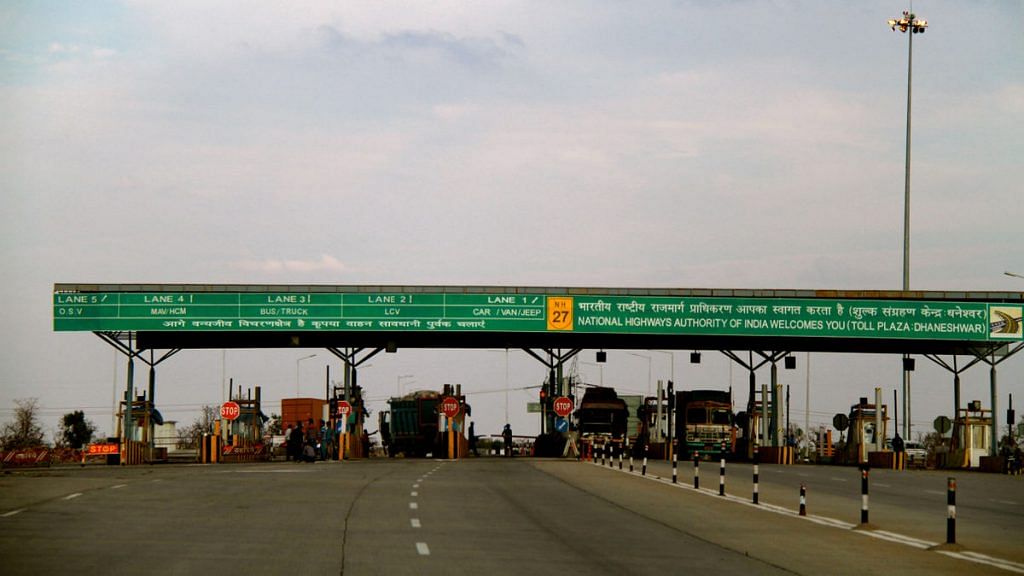New Delhi: Earlier this week, the Narendra Modi government made FASTag mandatory for toll collection at national highways. In a statement Sunday, the Ministry of Road, Transport and Highways (MoRTH) said that any vehicle not fitted with the tag will have to pay double toll fee to access the highways.
A FASTag is affixed to a vehicle and the fee is automatically deducted once the car passes through the toll plaza, eliminating the need to stop in queues.
A senior official in the Ministry of Road Transport and Highways told ThePrint that all 631 national highway toll plazas were operational with FASTags, along with 109 state-run toll plazas and 39 toll plazas that come under the MoRTH.
However, the official added, it will still take some time before all plazas on national highways will be able to collect fees only through FASTag.
At present, toll collection through FASTag makes up 85 per cent of the total collection, the official added.
The official also noted that states like West Bengal, Chattisgarh, Bihar, Maharashtra and Kerala are yet to shift completely to FASTag.
The national highways in Punjab and Haryana are also not operational currently because of the ongoing farmers’ agitation at Delhi borders.
ThePrint takes a look at what FASTags are, how they are being implemented across the country and their benefits.
Also read: Rs 1 lakh crore Delhi-Mumbai and Ambala-Kotputli expressways to be ready by March 2022
What are FASTags?
FASTags, which aid electronic payment of fees at toll plazas, were introduced in 2016. Each tag has a unique code for a vehicle and when one drives through the toll plazas, the fee is automatically deducted after the system scans the code.
They can be purchased and recharged on PayTM and Amazon, as well as websites of a few banks such as HDFC, Kotak Bank, ICICI and Axis Bank
According to the senior government official, as of 17 February, there were 60 lakh transactions made through FASTags worth Rs 95 crore, which is 16 per cent higher than the transactions made last week.
Once FASTags become 100 per cent operational in the country, the government expects an inflow of revenue worth more than Rs 100 crore.
In the fiscal year, 2019-2020, electronic toll collection was worth Rs 11,294 crore, while in the fiscal year 2020-21 (up till 17 February) the total electronic toll collection was Rs 18,556 crores — an increase of over Rs 7,000 crores.
India will also become the only country in the world to have one uniform e-toll collection facility once FASTags become the sole mode of toll collection.
After these became mandatory Tuesday, more than 9.2 lakh (9,29,725) vehicles had signed up for FASTags as of Friday. Officials noted they expect the number of toll collections through FASTags to increase in the coming days.
Also read: Onus on NHAI as new Modi govt rules require 90% of highway land arranged before work starts
Benefits of FASTags
FASTags have been a part of toll collection for years now, however, prior to this a hybrid model of collection was followed. One lane on the toll plaza was reserved for both cash payments and the tags. But this was counterproductive as it would lead to long queues, big traffic jams and more fuel emissions.
According to Vivek Chattopadhyay, air pollution programme manager at the Centre for Science and Environment, once FASTags are installed in all vehicles and toll plazas, it will be easier to pass through them and it will result in lower fuel emissions that are harmful for the environment.
“Due to the toll fee collection there were longer queues and more traffic jams, which resulted in an increase in fuel emissions,” Chattopadhyay said.
He explained that when the engine of a vehicle is at the optimal speed (40 km/hour) it releases less fuel compared to a vehicle moving at an idle speed. “The same engine when idle is emitting twice as many pollutants and burns more fuel. It is a waste of fuel. FASTags are a much better alternative.”
The central government is offering FASTags free of cost till 1 March to encourage their use.
According to government sources, to ensure more efficient FASTag roll out on state roads, outreach programmes for states are in the pipeline.
Also read: Modi govt limits app-based cabs’ surge pricing, licence must to operate service
